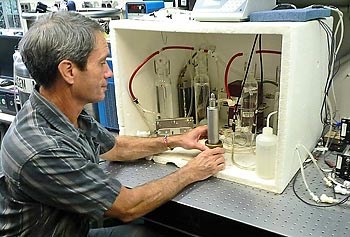Phillip Gibson Checked Fabrics for ‘Breathability’

Army Natick lab researcher and UMass Lowell alumnus Phillip Gibson with the test setup he used to check the fabrics for the U.S. Olympic Snowboarding Team’s uniforms.
02/18/2014
By Edwin L. Aguirre
Thanks to the work of a UMass Lowell alumnus, members of the U.S. Olympic Snowboarding Team competing in Sochi are wearing jackets that are not only waterproof and breathable, but also comfortable and warm.
Phillip Gibson of the Molecular Sciences and Engineering Team at the Natick Soldier Research, Development and Engineering Center (NSRDEC) performed tests at the Natick lab last year to help Burlington, Vt.-based company Burton Snowboards pick a fabric for the team’s official uniforms for the Winter Olympic Games.
“Burton wanted me to test fabrics to measure how much water vapor goes through and how breathable they are,” says Gibson, who received his doctor of engineering degree in mechanical engineering from the University in 1997. A snowboarding enthusiast himself, Gibson has more than a decade of experience working with well-known outdoor clothing companies such as Polartec, REI, The North Face, Columbia Sportswear and Nike.
Gibson’s test results were used by Burton to develop its new “DRYRIDE Vaporshell” laminate for the competition jackets. The jackets are printed with a patchwork quilt design and vintage American flag on the sleeve.
“We’re not endorsing the product,” he explains. “We’re just providing information, and the company decides how it wants to use it.”
Tests Use Patented Technology
Gibson performed the analyses on swatches of Burton’s proprietary clothing material using the Dynamic Moisture Permeation Cell (DMPC), a testing method he developed at NSRDEC that simultaneously measures water vapor diffusion and air flow resistance through a fabric.
“This technique is much faster than previous test methods,” he says. “It can use much smaller sample sizes and provides many unique measurements of properties that were not available using previous standard test methods.”
The Army obtained a U.S. patent for the DMPC in 1999, and Gibson’s method has since become a widely used standard in the outdoor waterproof/breathable clothing industry.
A Unique Partnership
Gibson recently donated one of his DMPC devices to the HEROES Initiative at UMass Lowell. The program, which stands for Harnessing Emerging Research Opportunities to Empower Soldiers, is a joint research and development initiative between the University and NSRDEC that taps the expertise and capabilities of both institutions to improve the survivability and protection of American troops.
“The unique capability of the DMPC is now available for use by University faculty and students,” says Lynne Samuelson, former chief scientist at NSRDEC who now co-directs HEROES together with plastics engineering Assoc. Prof. Ramaswamy Nagarajan.
“The DMPC will help foster collaboration in developing new advanced textiles for our soldiers as well as for dual-use commercial applications,” says Samuelson. “These include characterization of materials for novel chemical/biological and insect-repellent protective fabrics as well as understanding how air flows through materials to optimize parachute design.”
The DMPC is also expected to attract external partners in industry and academia.
“There are many local and regional textile, fabric and fiber companies interested in using this equipment,” says Samuelson, also a UMass Lowell alum. “For example, Dr. Gibson plans to do some DMPC testing at HEROES of new clothing materials for companies such as Celgard, Akita, Sympatex, MMT and Expansia. They offer great opportunities for University students and faculty to collaborate with both Army scientists and industry in developing new, advanced fabrics and fibers. And it’s fitting to conduct these types of textile research in the City of Lowell, where the textile industry began.”
Highly Motivated and Valuable Researchers
When he’s not testing materials for commercial companies, Gibson leads a team of about 25 NSRDEC scientists and engineers to develop flame-resistant and chemical-protective garments for U.S. troops.
Gibson credits the education and training he received at UMass Lowell in helping him succeed in his professional career.
“The personal interaction and guidance of my doctoral adviser, Prof. Majid Charmchi in the Department of Mechanical Engineering, was key to my education, especially in training me to use computational fluid dynamics to model heat and mass transfer in test systems, in fabrics and in the human body,” he says.
Gibson currently has two UMass Lowell recent graduates working in his team — Molly Clay and John Fitek, who received master’s degrees in chemical engineering and mechanical engineering in 2012 and 2010, respectively.
“Both are very motivated and valuable researchers, which are a tribute to their education at the University,” he notes. “We have a large number of UMass Lowell engineers and scientists working at the Army Natick labs, and we hope the HEROES partnership will help build on these links.”
For more information on how to collaborate with HEROES, contact Ramaswamy_Nagarajan@uml.edu or at 978-934-3454; or Lynne_Samuelson@uml.edu or 978-934-1755.